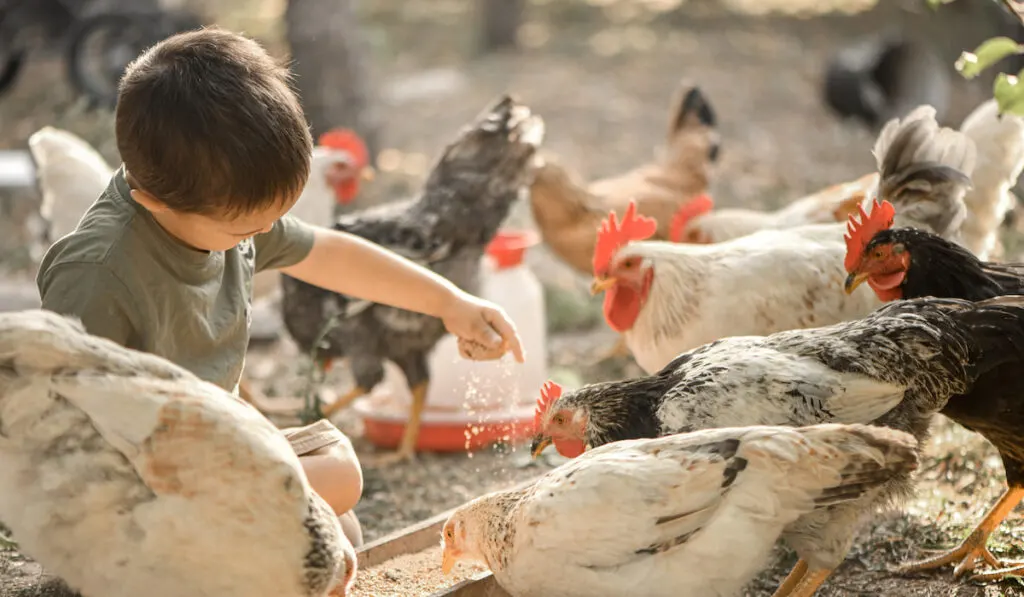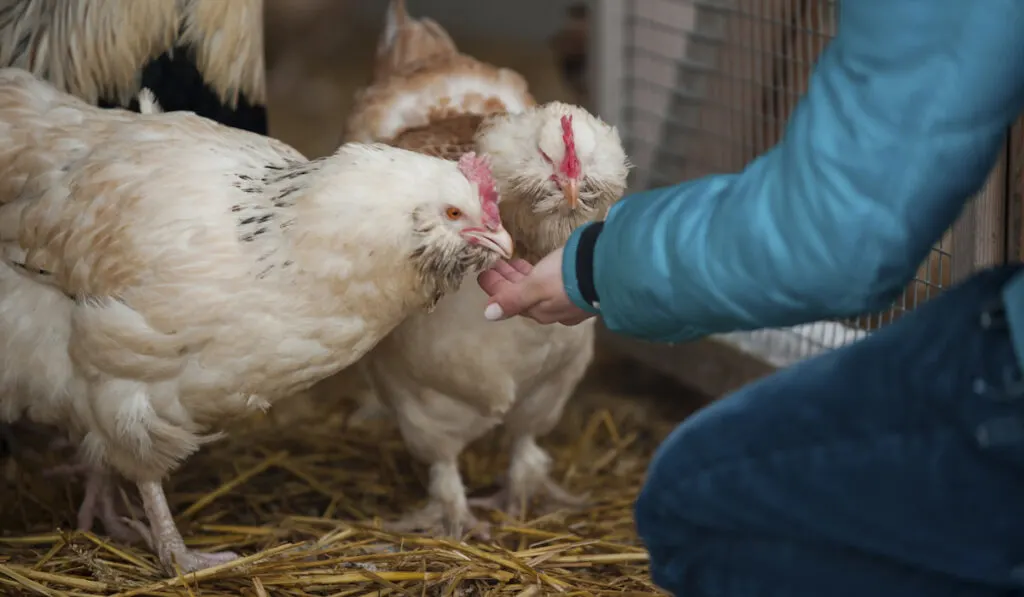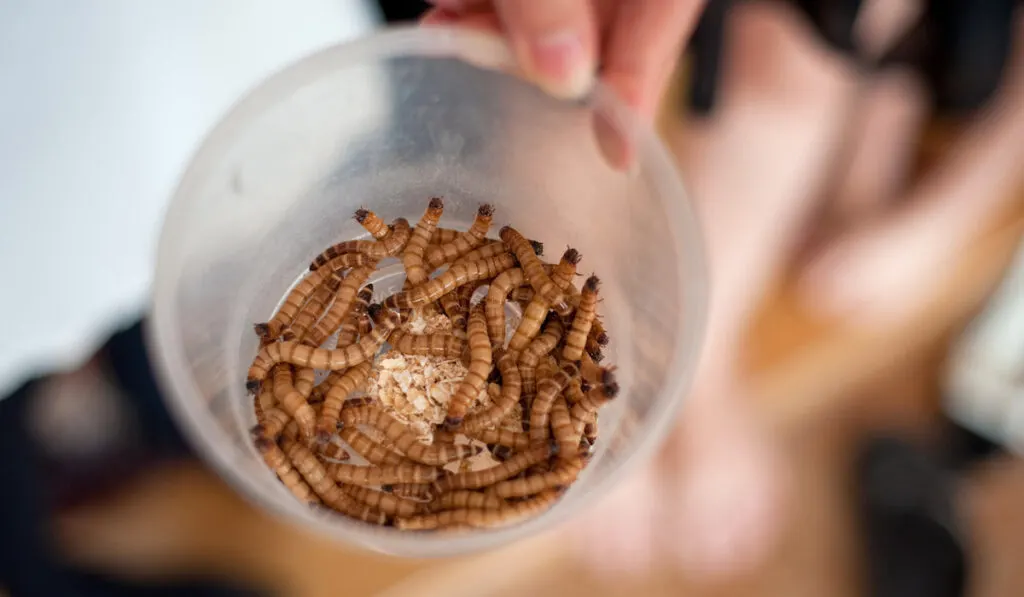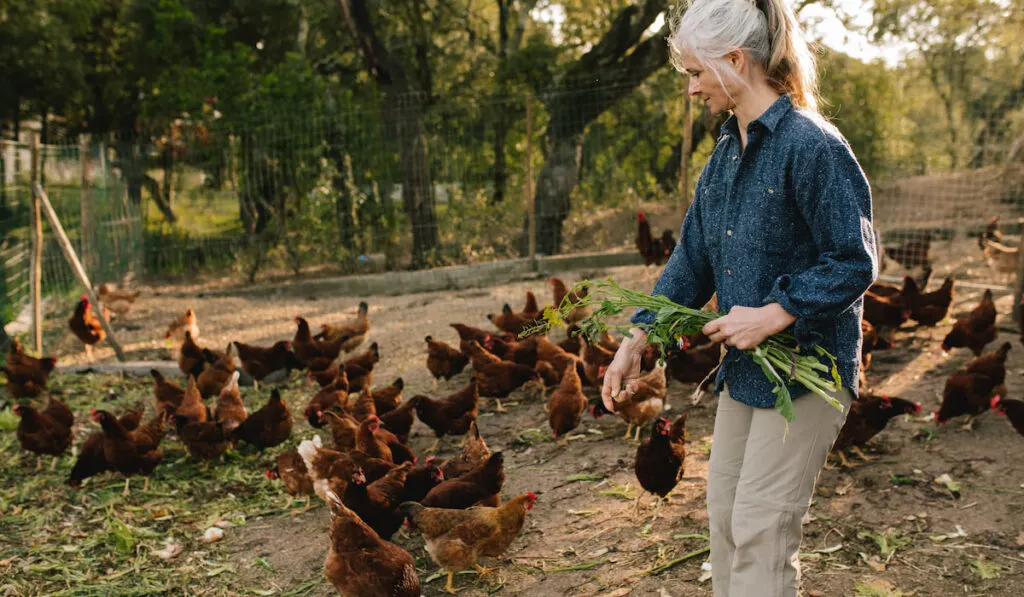Raising chickens is easy and rewarding but can also be expensive due to the high cost of feed.
Processed feed can include a proper blend of nutrients, but you also pay for the convenience of ready-to-serve blended feed.
Can you raise chickens without buying feed?
Chicken owners can raise healthy animals without feeding preprocessed feed. These methods can help owners save money and often offer healthier and more sustainable options for their animals.

In this article, we will share different ways to feed chickens without spending a penny on processed chicken feed.
Table of Contents
1. Raise Your Chickens on Pasture
Free-range chickens are typically quite happy and healthy because they get to explore and freely find different kinds of food.
Chickens do not just enjoy eating these foods on pasture. They get enough nutrition to grow from them. Here are some examples of food that chickens can find in free-range or pasture environments:
- Frogs
- Fruits
- Seeds
- Toads
- Lizards
- Snakes
- Insects
- Spiders
- Millipedes
- Mealworms
- Earthworms
Tips for Raising Chickens on Pasture
- Supplements. During the winter, your birds may not be able to find enough food in the pasture to sustain them as they did in other seasons. You may need to add supplements to their diet.
- Crowding. Do not over flock your birds. The fewer the number of birds you have, the more food your chickens can find on pasture.
- Immunization. Vaccinate your birds before allowing them to roam freely. This can help protect them from pathogens naturally found in the soil.
Pastured chickens must be given added meals for sufficient nutrition. Consider raising your chickens on pasture and growing supplemental natural feed to ensure that they remain healthy.
2. Growing Hydroponic Fodder
Hydroponic fodder is simply young grass grown from cereals and grains. Barley grass is the most common hydroponic fodder used for poultry and livestock, but other grains can be used.
Instead of giving cereals and grains to chickens (which can be expensive over time), these grains are grown to germinate, produce young leaves, and then they are fed to the chickens.
Popular cereals and grains used for hydroponic fodder are:
- Millet
- Maize
- Barley
- Wheat
- Guinea corn

How to Grow Hydroponic Fodder for Your Chickens
- Select Your Grain of Choice: You can choose from the list above or select any cereal (preferably a monocot) to make fodder for your birds.
- Soak in Bleach: You should soak your grains in bleach or any anti-fungal agent for 30 minutes to 1 hour. This will prevent fungi from growing. You should rinse off the bleach with clean water afterward.
- Incubate: Encourage a higher germination rate by incubating the seeds. Pour them into a bowl with a cover, and make holes in the cover so that oxygen can reach the seeds. Keep the seeds in this bowl for 2-3 days. Always make sure that there is moisture in the container.
- Prepare Your Trays: Make holes at one end of your trays for water drainage.
- Spread the Seeds on a Tray: When you see a lot of roots in your incubation bowl, carefully spread the seeds on a tray. The seeds should not be stacked over 2-3 layers. When spreading the seeds, leave a little space from the hole in the tray so that the roots will not block the hole.
- Water Regularly: You should water the sprouts twice daily (morning and evening). Keep watering for 3 days.
- Flood the Fodder: This step is not necessary but ensures that your hydroponic fodder is clean for consumption.
- Feed the Chickens: After 3 days on the tray (and after flooding the hydroponic fodder), you can feed the young grass to your chickens. It is not recommended to feed chickens with fodder that is 5 days or older because it contains more fiber and fewer proteins. Older fodder is for goats, cows, and other ruminants, not chickens.

Note that chickens need to get used to eating hydroponic fodder, so you should start with a small number of grains to prevent wastage.
3. Raising Earthworms
Earthworms are a natural choice for pasture chickens. Earthworms are not just great for soil; they make great feed replacement for chickens.
Three major benefits of raising earthworms are:
- Chicken Feed Supplement: Even though chickens cannot fully rely on earthworms, earthworms make great feed supplement for chickens.
- Sustainable Method of Disposing Food Waste: Earthworms eat food waste, so you do not have to worry about disposing of your kitchen scraps.
- Nutrient-Rich Castings for Fertilizer: As scavengers and detrivores (i.e. earthworms love eating decaying materials), earthworms will eat your food waste and excrete nutritious castings that can replace regular fertilizer in your garden.
How to Raise and Care for Earthworms
- Select Your Preferred Worm Species: There are many worm species. Examples are red wrigglers, African nightcrawlers, Alabama jumpers, and European nightcrawlers. Alabama jumpers are suitable for introduction into the soil (for pastured poultry), but for more protein choose either European or African nightcrawlers.
- Build or Buy a Worm Bin: You can save yourself some energy by buying your worm bin.
- Use Bedding in the Worm Bin: Worms need bedding for uniform moisture. Some great bedding materials are peat moss, straw, coconut husk, and shredded paper. You can use cow or horse manure, but make sure that it is composted for two months and the cow or horse were not dewormed before excreting the manure.
- Feeding Your Worms: Feed your worms by placing food scraps on the surface or buried under the soil. Make sure to place the food scraps at one end of the bin, and when it is almost finished, place food scraps at the other end.
- Harvesting Your Worms: A population of worms can double in size in 60-90 days. When they have fully established, you can harvest worms to feed your chickens so long as you do not collect all of them. You should rinse your worms with clean water before giving them to your chickens.

4. Raising Mealworms for Your Chickens
Mealworm is the larva of the mealworm beetle (Tenebrio molitor), a species of darkling beetles. Mealworm is rich in protein and makes a great feed supplement for your chickens.
Mealworms can grow to be 2.5 cm or more, so your chickens have more quantity (in addition to quality).
How to Raise and Care for Mealworms
- Prepare Your Container: You can use any container. Most people use aquariums or transparent containers to see what is going on inside. Your container should be 12 by 24 inches and 12 inches deep. You should use a screen mesh to cover the container so that the mealworms do not escape.
- Add Your Substrate: The feed is called a substrate. It should be at least 2-3 inches deep. Examples of suitable substrates for mealworms are wheat bran, rolled oats, and chicken mash.
- Introduce Your Mealworms: You can purchase mealworms from various feed mills, poultry shops, or even order them online.
- Continue Feeding the Mealworms: If you notice a reduction of the height of their substrate, add more food into the container. You should also water the container when it is dry.
- Harvest the Larvae to Feed Your Chickens: In just a month, you can collect some larvae to feed your chickens. Do not collect pupae or adults (so that they can reproduce to lay more eggs). Wash the mealworms before giving them to your chickens.
5. Fruits and Veggies
Earthworms and mealworms are excellent sources of protein for your chickens.
To get more nutrients such as minerals and vitamins, however, your chickens will need fruits and vegetables.
Some suitable vegetables for chickens are:
- Kale
- Beets
- Lettuce
- Spinach
- Cabbage
Some great fruits for chickens are:
- Apples
- Grapes
- Banana
- Cucumbers
- Watermelon
Before giving your chickens any fruit for the first time, make sure that they are safe for chickens. Fruits such as Avocados are not great for chickens.

6. Accepted Kitchen Scraps for Your Chickens
Of course, you can feed your chickens with kitchen scraps. Since not all kitchen scraps are suitable for chickens, here is a list of accepted scraps that you can feed your chickens with:
- Bread crumbs
- Grains
- Meat and fish
- Eggshells
- Most fruits and vegetables
Some food items to never give to your chickens are:
- Avocados
- Chocolate
- Moldy or rotten foods
- Soft drinks
- Potato peels
Which Available Option Is Best for Your Chickens?
All natural methods of feeding chickens without purchased feed are excellent, but which is best for your chickens?
| Feed | Protein Content (per 100 grams) | Fiber Content (per 100 grams) | Production Rate |
| Mealworms | 20.27% | 1.73% | Slow |
| Earthworms | 54-59% (dry matter) | 0.36% | Medium |
| Barley Fodder | 15-17% | 8.9% | Fast |
| Housefly Maggot | 47% (dry matter) | 7.5% | Fast |
| Black Soldier Fly Maggot | 43% (dry matter) | 6% | Fast |
Earthworms have the highest protein content but that is for their dry weight (meaning that they will have a lower protein content when fresh because of high moisture).
When feeding your chickens, feed them with food made of plant and animal products because chickens are omnivorous. You should always make fodder for your chickens.
Final Thoughts
You do not have to buy processed feed for your chickens. Chicken feed is expensive, so you should look for other ways to feed your chickens. You can make hydroponic fodder, raise earthworms, mealworms, and other kinds of food for your chickens.
